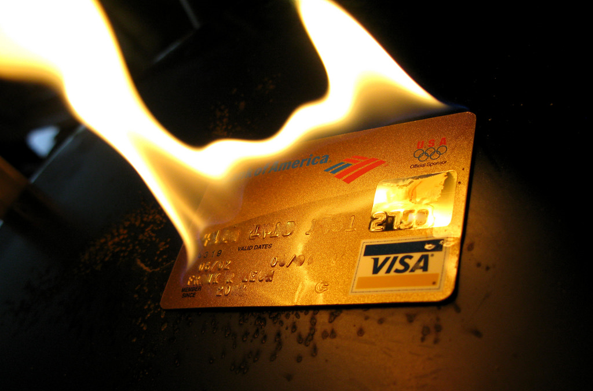** DRAFT - NOT PUBLICALLY VISIBLE **
On our blog, we've often talked about the advantages that a credit card has to offer, as well as the ways in which you can benefit by simply owning a card and using it at regular intervals. A credit card not only allows you to build your score, but also gives you easy access to funds when you need them the most. However, sometimes it happens that the perks derived from a credit card are not enough to offset its drawbacks. For example, you may be paying exceptionally high annual fees or steep interest rates for a card whose rewards don't justify its charges. In such cases, you may be tempted to cancel the card and switch to a new one.
But beware! Before you snip your card in two, there are certain issues that you need to take care of - else you may damage your score or complicate the process of switching to a new card. For your benefit, we've compiled a list of the steps that you should take before canceling a credit card.
1. Comprehend the Impact of Closing a Credit Card.
First, you should understand that closing a card may have a negative impact on your FICO score, as it can not only decrease the amount of credit available to you, but also reduce the length of your credit history. An increase in credit utilization ratio (i.e., used credit vs. available credit) beyond 30% can ding your credit score. Moreover, if you've had positive history on your card, you may suffer as closed accounts generally do not influence your score as much as open accounts.
2. Talk to Your Issuer.
If you are closing a long-standing account due to an increase in rates or unfavorable fees, contact your issuer and find out if they would be willing to reduce your rates or waive the fees. At times, this strategy may work because card companies find it more expensive to attract new customers than to retain existing ones. In some instances, such as airline rewards credit cards, you may find a lower tier card available at a lower (or no) annual fee.
3. Transfer Automatic Payments to Another Card.
In case you nevertheless decide to close your account, first make preparations to transfer all automatic payments to a new card. Peruse your last few statements to identify automatic charges, and then contact those companies or make online changes in your card information to ensure that future payments are met even after the current card has been closed.
4. Redeem Rewards on the Existing Card.
Most cards offer rewards, and if you close one in a planned manner, you may be able to partially or fully redeem the points that you have accumulated so far in the form of travel miles, merchandise or even statement credit. In order to do this in an efficient manner, check your balance and redemption rules online.
5. Close the Card.
Once you've carried out all the above steps, you'll be in a position to cancel your credit card. For this, you'll need the customer service number and mailing information. This information can usually be found on the credit card, monthly statement or issuer's website.
Next, pay your balance in full or transfer it to another card if you get a good balance transfer deal. This step is important since a card that has an outstanding balance cannot be closed. In order to avoid accruing more charges, you can even ask your issuer to freeze your account until the objective has been achieved.
Once you've paid off the balance, confirm that it is indeed zero and that there are no pending charges or residual interest that you need to take care of. Then, contact the bank's customer service representative to inform them you are cancelling the card. Make sure you have it noted that the account was cancelled on the customer's request. Also, request a written confirmation regarding the closure of the account.
The entire process of closing a credit card may take a month or more, hence it is important that you exercise patience during this time. After this time has elapsed, obtain a free copy of your report (e.g., from AnnualCreditReport.com) and check it to confirm that the account is really closed. If not, report the mistake by calling the customer service number, and also inform the company in writing. If the issue persists, file a dispute with one of the three credit bureaus or take it up with the Consumer Financial Protection Bureau.
$50,000 - $250,000 of Unsecured Credit at 0% Interest
While certain credit cards accounts may need to be closed due to their exceptionally high fees, there are others that can get you as much as $50,000 - $250,000 of unsecured credit! Through creative credit card financing, Fund&Grow enables its clients to get funds at 0% interest. For a flat fee, our team not only guides you through the entire process, but also holds your hand every step of the way. To learn more about this, call us at (800) 996-0270.
Popular Posts
Instantly Pre-Qualify
Want Actionable Information, Tools and Resources To Quickly Acquire Business Capital, Credit and Funding?
I take tremendous pride in building positive and lasting relationships in my businesses and personal life. Every member of my team is committed to helping our clients get the maximum amount of funding possible and achieve their highest growth potential.

have a question?
Our business experts are available to answer questions Monday - Friday from 9:00 a.m. - 6:00 p.m. EST
Call Us:
(800) 996-0270
Email Us:
service@fundandgrow.com
Watch our Masterclass:
Access up to $250K in 0% Business Credit
Let's Stay Connected on Social Media!

* "Funding" typically comes in the form of the issuance of business credit cards that may be used for business purposes. In such instances, we consider these credit lines as funding since businesses may tap those lines.
** Zero-Interest is based on the personal credit-worthiness of the business owner. 0% rates are introductory rates and vary in length of time, assuming all monthly required payments are made to the credit card company. Introductory rates of 0% apply to purchases and/or balance transfers after which it reverts to an interest rate, which varies by lender as disclosed in the lending agreement from the lender. Fund&Grow is not a lender.
*** The 60-day money-back guarantee only applies if client does not obtain credit. Please refer to the full Terms of Service for additional details.
Contact
Information
All credit is subject to lender approval based upon credit criteria. Up to $250,000 in business credit is for highly qualified files over the term of the membership with multiple credit card batches and/or credit lines. Introductory rates of 0% apply to purchases and/or balance transfers after which it reverts to an interest rate, which varies by lender as disclosed in the lending agreement. Fund&Grow is not a lender.
© 2025 Fund&Grow. All Rights Reserved.

 Share
Share








